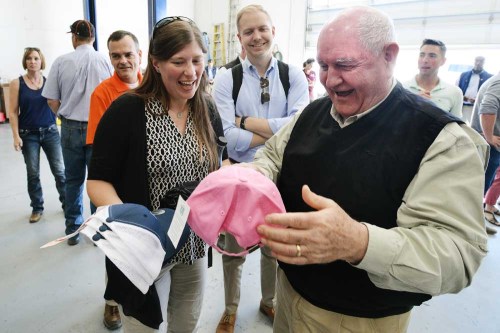How the $19 billion in federal aid will help farmers and ranchers
Published 12:00 pm Tuesday, April 21, 2020

- U.S. Secretary of Agriculture Sonny Perdue, shown during a visit to Rufus in 2018, has announced a $19 billion aid package for farmers and ranchers.
SALEM — The USDA has announced $19 billion in federal aid that will be distributed this spring to help farms and ranches across the U.S. survive the plunging prices caused by the COVID-19 shutdowns.
The package, called the Coronavirus Food Assistance Program, is part of the $2 trillion Coronavirus Aid, Relief and Economic Security Act that Congress passed in March.
“The program will include direct payments to farmers, as well as mass purchases of dairy, meat and agricultural produce to get that food to the people in need,” said President Trump at a White House briefing Friday.
CFAP will issue $16 billion in direct payments to farmers and ranchers and $3 billion in food purchases.
Industry experts say the aid comes at a critical time. Across the nation, farms that have lost restaurant orders and can’t divert supply lines in time are dumping thousands of gallons of fresh milk into lagoons and manure pits, digging ditches to bury produce and plowing under ripe vegetables.
“The losses are devastating,” said Michael Nepveux, economist at the American Farm Bureau. “This aid package is so necessary.”
But how will USDA officials decide which commodities and individual farmers and ranchers will receive aid?
Direct payments
Although USDA has not confirmed final numbers for direct payments to farms and ranches, Nepveux said a leaked copy of an embargoed release gives approximations, including:
- $9.6 billion for the livestock industry, including $5.1 billion for cattle, $2.9 billion for dairy and $1.6 billion for hogs.
- $3.9 billion for row crops.
- $2.1 billion for specialty crops.
- $500 million for other sectors, including poultry, sheep, hemp and niche sectors.
None of the money will be used for biofuels or ethanol, Agriculture Secretary Sonny Perdue said at a press briefing Friday.
Nepveux said the Farm Bureau is advising USDA so producers suffering losses, including small farms, won’t be overlooked.
“We don’t want to leave anyone behind,” said Nepveux.
Direct aid
To qualify for direct aid, a commodity must have declined in price by at least 5% between Jan. 1 and April 15.
According to industry experts, most agricultural products easily qualify. For example, since the start of 2020, live cattle prices have plummeted 25% and hog prices 53%.
USDA has yet to confirm what “price series” — or system used to compare the standard price of a good — it will use. For specialty livestock and crops, calculating price series and losses is complicated and may take longer, experts say. A USDA spokesperson said the agency will specify in its upcoming rulemaking what specialty category producers need to do to demonstrate losses.
The payment limit is $125,000 per commodity with an overall limit of $250,000 per individual or entity.
When and how
Perdue said USDA will most likely use existing infrastructure, such as its Farm Service Agency, to distribute checks.
“I’m hoping we can get checks by the end of May,” said Perdue. “It’s an arduous process.”
But it is still unclear whether checks will go out or sign-ups will begin by that time. A USDA spokesperson told the Capital Press on Monday that “sign-up for the direct support is expected to begin by the end of May (and) more information will be provided when the rule is published.”






